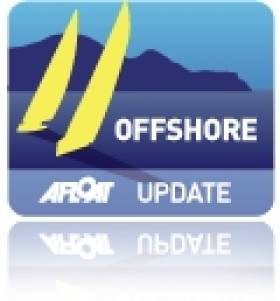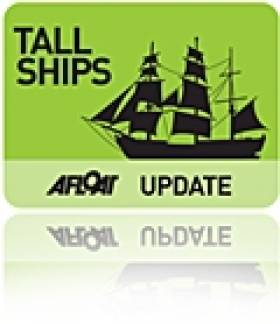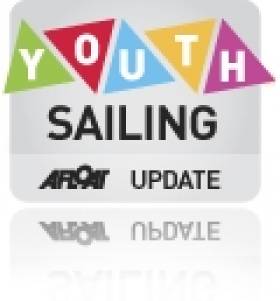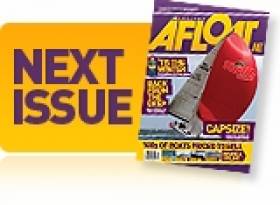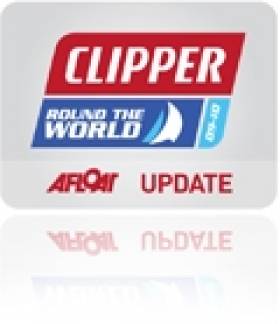Displaying items by tag: Afloat
Nixon's Impressive Result in Boston Makes Her Afloat Rower of Month
# ROWING: The Afloat Rower of the Month for October is Holly Nixon. The 18-year-old Fermanagh woman is on scholarship to the University of Virginia in the United States, and she rowed in the number three seat of the crew which finished an impressive third in the Women’s Championships Eights at the Head of the Charles in Boston. This was the top position for a college crew, and placed them ahead of the Dutch and Canadian national teams.
Rower of the Month awards: The judging panel is made up of Liam Gorman, rowing correspondent of The Irish Times and David O'Brien, Editor of Afloat magazine. Monthly awards for achievements during the year will appear on afloat.ie and the overall national award will be presented to the person or crew who, in the judges' opinion, achieved the most notable results in, or made the most significant contribution to rowing during 2012. Keep a monthly eye on progress and watch our 2012 champions list grow.
2500 Facebook Fans! Thanks for 'Liking' Afloat
#FACEBOOK – 2,500 people now follow Afloat magazine on Facebook, the social media site. Thanks to all our friends for your comments, suggestion and interest in Irish boating.

We enjoy bringing you timely updates on Irish boating and sailing, clearly readers like them too! We look forward to seeing more and more of you on our Facebook page. 'Like' Afloat here and get daily boating updates on your facebook wall.
Boats are Selling - Get Your Boat Sold on Afloat.ie
#BOATS FOR SALE – In spite of the doom and gloom boats are still selling through Afloat and we've had good news from one customer this week who sold his yacht within a few weeks of the advert going up on the Afloat boats for sale site.
Cork sailor Ian Travers advertised his Quarter Ton yacht Bandit in May for €11,500 and we received a letter yesterday telling us the deal was done and his yacht was sold. Well done to Ian and we look forward to seeing him and the new owners of Bandit on the water in 2012!
Here's Ian's note which maybe of interest to those considering selling over the winter lay up period.
Dear Afloat,Just a quick note to let you know I have sold my Quarter Tonner 'Bandit'.
I am sure you will be glad to know I received loads of interest from the online advertisement I placed with Afloat.
As soon as the ad was placed, I started receiving enquiries from people who saw her on your website.
Categorically she would not have sold as quick had I not advertised with afloat.ie.
I would now be grateful if you could list the boat as being sold.
Thank you for your efficient service and I would not hessitate in recommending your service to anyone wishing to sell their boat.
Kind Regards,
Ian Travers
To advertise (€10) on Afloat's boats for sale website click here
Mathews and Kenefick Onboard Germany's 'AOC Rockall' for Middle Sea Race
Although there are no Irish boats at least two Irish crew are participating in Saturday's record breaking Rolex Middle Sea Race from Malta.
Dun Laoghaire navigator Brian Mathews, who narrowly misseed out on an international victory in the Dragon fleet with Martin Byrne in Cannes last month is sailing with Crosshaven's David Kenefick on board the Ex-'Rosie' 36 footer, now the German Registered AOC Rockall racing in IRC class four.
A record has been broken even before the start of the Race say the organisers. Days before final registration for this year's event, entries have risen to a record breaking 81 and there are still a few days to go before the last entry can be accepted.
New entries from Italy, Serbia, Slovenia and the UK have pushed the numbers up to 80, three more than the previous record of 77 in 2008.
"We can accept late entries up until 17th October and we do expect one or two more, said Georges Bonello Dupuis, Commodore of the Royal Malta Yacht Club. As it is, entries for this year are incredible and we are really looking forward to seeing them all berthed outside the Club; the place will be buzzing," he added.
A handful of boats are here, including previous RMSR line honours and overall winner, Alegre together with the back to back winner of the Rolex Fastnet, Ran 2.
Other arrivals include the UK Swan 57 Yellowdrama who'll be fighting for the new Nautor Swan Cup, Echo, Doppelbock (Germany & UK) and Filando and Tyke from Italy. Filando's 14-man crew come to Malta for the first time to take part in a race that they consider "the best offshore regatta in the Mediterranean."
Many of the entries will arrive this weekend, including the brand new 85 foot Nautor Swan ,Berenice from Italy. While good weather over the weekend will ease the passage of arriving yachts, Mr Bonello Dupuis cautioned, "I expect one or two might have problems making their way down to Malta, but fingers crossed that everyone arrives safely; they will certainly receive a warm welcome."
The Rolex Middle Sea Race is organised by the Royal Malta Yacht Club in association with the Royal Ocean Racing Club (RORC) and has been sponsored by Rolex since 2002.
'Class Afloat' Tall Ship to Visit Belfast Next Week
West Island College International - Class Afloat is one of the world's most unique and interesting educational experiences. It offers high school and university students the opportunity to take fully accredited courses while sailing aboard a traditional fully-rigged class 'A' tall ship built in 1924.
Some facts about Class Afloat:
Created in 1984 as a Canadian International Youth Year programme.
Has visited ports of call on every continent of the world.
Students and staff participate in two service projects in the Dominican Republic and in our West Africa Initiative in Dakar, Senegal
Students tend to come from the top 25th percentile in their home schools and 98% of our students attend the university of their choice after graduating with us
Students spend four hours a day outside of the classroom learning how to run and maintain the ship
Students leave the program having developed strong leadership skills, an ease at working in groups, a sense of responsibility and accountability, ready to participate as an active and conscious citizen.
More on the website here
Youth Boat Selection Requires Leadership
There has been a call for the Irish Sailing Association (ISA) to take a lead in the big decisions that face youth sailors on what classes to sail to after they leave the ranks of the Optimist, Topper and Feva classes. The call comes from a leading junior organiser who does not wish to be named.
Although youth sailing is buoyant in Ireland it is known there is a 'high attrition rate' among teenagers. The lack of transfer in to senior dinghy classes has been a cause of concern for many clubs around the country.
The comments follow a recently published article on Afloat.ie promoting the RS 200 dinghy as a progression boat for juniors.
"We need a class that will keep youths engaged. The 420 and 29er are great boats but require higher levels of boathandling, are much more competitive and tend to attract the top sailors"
"While the ISA's Olympic ambitions are great to see, it will fail the sport as a whole if it does not tackle this gaping need, the organiser says.
Read the RS 200 article by Ciara Byrne and the junior organiser's comments here
Is Your Sailing Website Always Out of Date? Here's the Solution!
Would a constant stream of Irish sailing and boating news give your site the lift it needs?
Afloat.ie, Ireland's leading source of boating and sailing news, offers a news feed to bona fide clubs and classes wishing to keep web sites fresh and up to to date.
Webmasters can avail of the simple RSS feed and all we ask in return is for you to observe our rules and give Afloat.ie a link on your club homepage.
It couldn't be easier, click for the Afloat. ie RSS feed.
Look Out for Autumn Afloat!
New York Crew Set To Commemorate 9/11 Afloat
Through their participation in the 40,000-mile round the world race, the New York crew is raising funds and awareness for the National September 11 Memorial & Museum, a not-for-profit organisation created to design and run the Memorial and Museum at the World Trade Center.
At 1246 GMT (0846 EST) on Sunday, exactly ten years after the first plane hit the Twin Towers, the team of 18 led by skipper Gareth Glover will hold hands and observe a minute's silence before casting wreaths of remembrance into the Atlantic Ocean.
For the Clipper 11-12 crew members who hail from New York, the ten-year anniversary will be especially poignant.
New York crew member for Leg 2, Pat Coppolechia is a lawyer and a New York resident, and admits that Sunday will bring back powerful memories.
"In my wallet I've got the times that the planes hit the Towers and the times that they collapsed. It is certainly going to be on my mind and I'll reflect on where I was when it happened and the whole impact it had on New York and the world as a whole. I think there's going to be a moment of vulnerability and concern for those at home and everywhere around the world on the tenth anniversary," Pat said.
New York is racing around the globe alongside nine other internationally sponsored teams, all of whom will put their rivalries aside to remember the people who died in the terrorist attacks on 11 September 2001 with a minute's silence.
Just over ten years ago the biennial Clipper Race visited New York in August 2001, enjoying a stopover at Liberty Landing in New Jersey overlooking the Twin Towers after racing from Brazil. The fleet set sail on 31 August just 11 days before the attacks.
Former crew member Sarah Thorogood, who took part in Clipper 2000-01, said many of the crew enjoyed trips to the top of the Twin Towers during their visit to the city.
"We heard about the attacks mid-Atlantic when one of our crew called his son on the satellite phone. It was a huge shock and hard to comprehend when so many of us had been to the top of the Towers just a few days before. It didn't fully sink in until we arrived in Jersey when we saw the shocking images," Sarah said.
The New York team is endorsed by Empire State Development, the agency responsible for promoting business and economic development throughout the state, which is proud to see its powerful marketing message taken around the world on the yacht's distinctive livery featuring the iconic 'I love New York' branding.
The Clipper Race was established 15 years ago by sailing legend Sir Robin Knox-Johnston, the first man to sail solo and non-stop around the world in 1968/69. The name of the race was inspired by the trade routes followed by the early clipper ships and over a century later Sir Robin's ten identical stripped down 68-foot ocean racing yachts are using the same trade winds to help global destinations boost business and tourism through their participation in this unique event. Each yacht represents an international city, region, country or company.
The race makes an official stopover in New York between the end of leg seven and the beginning of the eighth and final leg of Clipper 11-12.
The Clipper Race departed the UK at the end of July and raced to Brazil via Madeira. The ten teams are currently gearing up to start Leg 2 to South Africa on Saturday. After a well-earned stopover in Cape Town, the matched yachts will race to Australia, New Zealand, Singapore, China, Panama, USA, Canada, Northern Ireland and the Netherlands before returning to the UK just before the opening of the London 2012 Olympic Games in July next year.
With the strap line 'Raced by People Like You', the Clipper Race is the embodiment of Sir Robin's vision to enable people from all walks of life to experience the thrills and challenges of ocean yacht racing: ordinary people doing extraordinary things. Each of the teams is led by a professional skipper but the crews are all amateurs, nearly 40 per cent of whom have never sailed before undertaking their extensive pre-race training. Five hundred people will participate in Clipper 11-12 with around 100 racing the full 40,000 miles and the remainder joining for one or more of the eight legs of the competition.
'Prodigious' Takes Pride of Place on 'Afloat Boats for Sale' Site
'Prodigious' is a very special, go anywhere motor yacht according to her broker, Hugh Mockler of Crosshaven Boatyard. This Weymouth 51 foot motor cruiser has just been added to Afloat's Boats for Sale site today and this 1988 craft is taking pride of place.
Originally constructed in accordance with Lloyds rules under the supervision of a Lloyds surveyor. In 2000 she underwent an extensive refit at the renowned Fairlie Restorations yard at Hamble and flew her pre purchase survey - the highly regarded David Hopkins declaring "She is the best example of her type that I have personally seen and she is in a good, sound and seaworthy condition."
The boat is lying on the south coast of England and priced at £229,000
All the details and specs are on the Boats for Sale site here. Vid below here too.





























